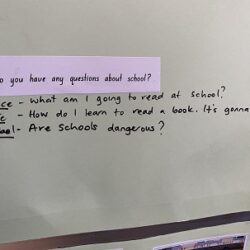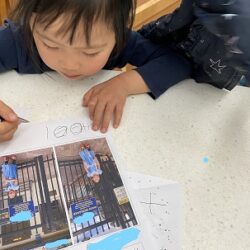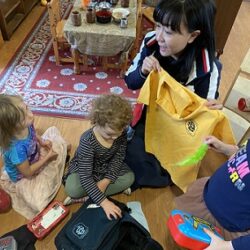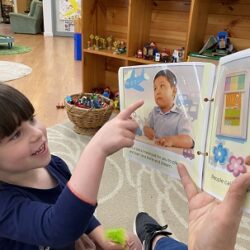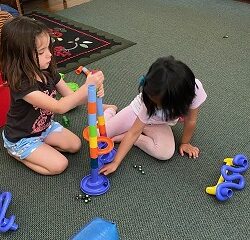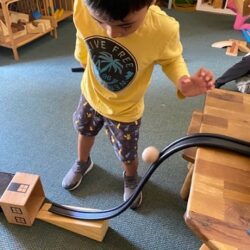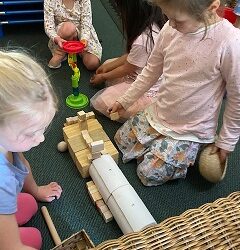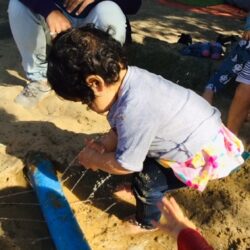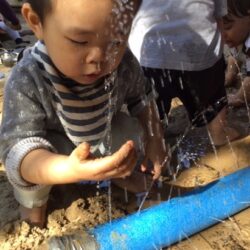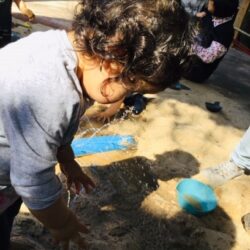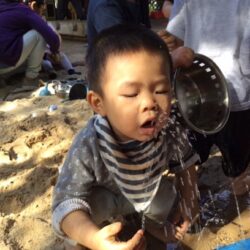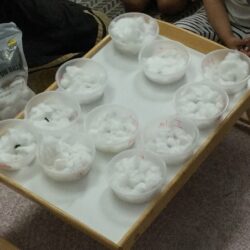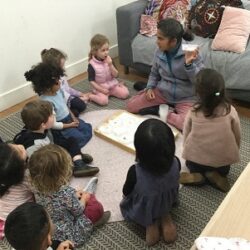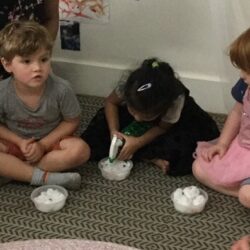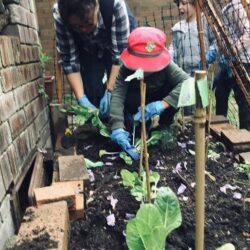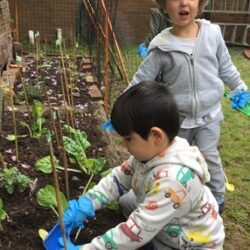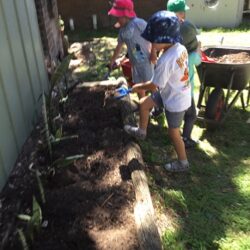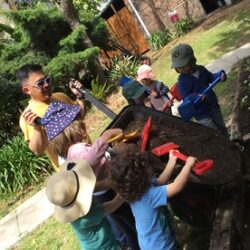Gorton House
Story by Educator Nicky
Many of our children are due to start school in the new year, but some of the usual avenues for supporting this transition have been interrupted by COVID-19. Our children and educators have had to be quite creative in how children are supported to feel empowered, comfortable and even somewhat familiar with these new spaces, as for many children the usual onsite and classroom orientation visits have been reduced or even cancelled due to COVID.
Educators thought long and hard about how to ensure that children had opportunities to see their school, to talk about and share what they saw with peers, and to share their enthusiasm and their worries or concerns. We wanted to ensure that children knew that others before them had felt the very same feelings and we revisited photos of children from the previous year, who had been to visit us in their uniforms over the early months of 2020.
We rallied the support of families and sent them on missions with their children to visit their school on the weekend, peek through the gates, take a photo of their child standing in front of the school sign and to then send us the photos so that each child could share with their friends all they have seen and learnt about their school. This has generated so much enthusiasm, with the children excited about the idea of their school having chickens, or playground equipment. Another child told us about the bees and the beehive and the gardens she saw through the school gate. We have accessed and read some brilliant books on starting school, and created a space where the children’s experiences, photos and thoughts can be documented, displayed and reflected on by themselves and others.
Involving families in this has been key, as families play a crucial role in understanding and supporting their child well after they leave the preschool room. Families have also been donating surplus uniforms for the children to wear in the dramatic play space, and lunch boxes and school bags have been added to the family home corner, so that children can enact the anticipated routine of preparing for, and going to school.
Whilst all this enthusiastic play and discussion has been occurring, the children also have the opportunity to share some of their feelings. Some have stated that they are so excited, or so happy, while others have expressed they feel both excited and nervous. During a story one child told us “I’m really, really scared about going to school.” He then explained that being in school without his usual friends is very scary and this has typically been the primary concern of almost all of the children. We have engaged in many discussions, acknowledging all feelings as valid, in particular the feeling of being without friends or being nervous, and emphasising that many children might feel this way. We have discussed what you could do if you found yourself in the playground feeling lonely, so that the children have some strategies they can try in various circumstances. We have encouraged children to share their feelings and understanding of school in their drawings. After some of these initial discussion one child reflected this in her drawing so beautifully! She narrated the meaning behind her drawing: “This is me, feeling sad because I miss my mummy, but then a person came and said “Are you OK?” and I feeled loved.” She drew several love hearts to represent the love that she knew would also be there even when initially she felt sad.
We believe it is important to foster a sense of resilience, and to support children to understand the potential process of their feelings, and that they may feel nervous and uncertain to start with, but there will be people who care about them, and that they can do something (for example, introduce themselves to peers, invite others to play etc) and that when they have met and made friends they will begin to feel comfortable and safe again. We have also emphasised that they might be the person that helps another frightened person to feel cared about and safe!
Johnson House
Story by Centre Director and Educator Amy
Play based learning is an important aspect of the Johnson House program and often the experiences provided are designed to promote holistic learning (which recognises the connectedness of mind, body and spirit).
Our marble and ball run experiences are great examples of how learning can be enhanced in a variety of ways. Two types of marble run experiences have been offered to the children: the traditional type with pipes and marbles, and the other with balls and rubber tubing. Some of the children were precise with the detail and their planning, while others used one or two provisions to develop ideas around ramps, height and speed. A lot of conversations between the children took place throughout the week during these experiences. We spoke a lot about sharing ideas with others respectfully, problem solving and persistence. We even spoke of the importance of acknowledging other people’s ideas even if our ideas are a little different.
While on the surface these experiences may be seen as simple investigations of cause and effect, what we have also been focusing on is the social connections that take place during play and the effective exchange of ideas, collaboration and persistence. It was great to see the children starting to take the lead in initiating such interactions, and being mindful of how their actions during play can help promote positive play experiences.
Murray House
Story by Educator Jung
As the weather is becoming warm and feels like summer, educators in Murray House have introduced water play this week.
Educator Latha made a water sprinkler in the sandpit and the children loved the experience! They all become excited when they saw the water sprinkling up into the air. The educators saw the children trying to collect the water drops with their hands and using bowls in the sandpit. Some children almost jumped inside the sprinkler’s spray to explore their senses by touching and mouthing!
Educator Jung added some plastic dispensers to the sand pit that were filled with water. The children seemed curious about these everyday objects, and they used different strategies to get the water out of them. They pumped and tilted the bottles and led the play into mathematics-based activities as they continued to fill the containers and watch them empty.
Water play fosters curiosity, imagination, and experimentation. It also provides stimulating sensorial play experiences for children and, most importantly, it is fun and engaging, especially on warm days.
Rigby House
Story by Centre Director and Educator Isa
The children in Rigby House are very interested in plants and gardening. Recently they planted seeds in our vegetable garden, and now they are patiently waiting for the plants to grow.
To support the children’s understanding of what seeds are, and how they germinate, the educators provided a seed germination experiment. The children have all taken charge of a bean seed. They placed their seed on cotton wool, ensured that they were in a sunny spot, and watered them regularly.
When they next came to check on their seeds, the childen were delighted to find tiny green shoots. The seeds had germinated!
The children continue to care for their plants, and to check on them every day to see how they are growing and changing.
Robinson House
Story by Educator Karen
Gardening for active minds
‘When a child grows a plant from a seed or seedling, be it in a garden bed or pot, they begin to realise through a bit of trial and error that the plant’s survival depends upon some regular care and attention’. (Jamie Durie, 2005, Outdoor Kids A practical guide for kids in the garden,).
Almost a month ago the children in Robinson House’s back room planted bean seeds in cups, and waited for them to sprout. This activity helped the children to become aware that trees and plants come from seeds. Since then, we have engaged with different rhythms of nature to explore other ways of maintaining our awareness, understanding and enjoyment of the natural environment and how everything is connected with the land.
Two weeks down, we noticed that the seedlings were inundated with bugs and insects and couldn’t be saved. This didn’t stop the children’s determination and their caring nature, and they planted the new shoots (bean plants) directly into the garden. With spring in full bloom, we made new garden beds out of bricks, logs and dirt. The children worked really hard at planting their vegetable garden, which they admired with happy smiles.
Watering the plants was a delight to the children, and they enjoyed seeing each plant stand tall and watching them grow. However, snails were then found feasting on our newly planted beans. How disappointing it was after all of the children’s hard work to see only two plants still standing tall in their garden. The children were encouraged to splash garlic wash and water over the plants as a natural snail repellent.
We were then given a planter with silver beet, tomatoes, lemon thyme and oregano to add to our garden. With persistence, acceptance and good nature, the children were once again adding to their garden. What an experience for the children to face, with so many trials and error, being tested both physically and emotionally. One thing is for sure, our children are always ready for new learnings. Our new gardens are once again filled with healthy plants, all standing in a row. We will continue to care for and nurture our newly planted vegetable garden and we hope to harvest our crop in the near future.
